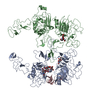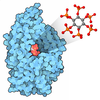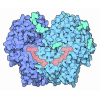+ Open data
Open data
- Basic information
Basic information
| Entry | Database: PDB / ID: 8hgo | ||||||
|---|---|---|---|---|---|---|---|
| Title | The EGF-bound EGFR/HER2 ectodomain complex | ||||||
 Components Components |
| ||||||
 Keywords Keywords | MEMBRANE PROTEIN | ||||||
| Function / homology |  Function and homology information Function and homology informationpositive regulation of hyaluronan biosynthetic process / negative regulation of secretion / negative regulation of cholesterol efflux / negative regulation of immature T cell proliferation in thymus / ERBB3:ERBB2 complex / ERBB2-ERBB4 signaling pathway / GRB7 events in ERBB2 signaling / positive regulation of epithelial tube formation / RNA polymerase I core binding / positive regulation of cerebellar granule cell precursor proliferation ...positive regulation of hyaluronan biosynthetic process / negative regulation of secretion / negative regulation of cholesterol efflux / negative regulation of immature T cell proliferation in thymus / ERBB3:ERBB2 complex / ERBB2-ERBB4 signaling pathway / GRB7 events in ERBB2 signaling / positive regulation of epithelial tube formation / RNA polymerase I core binding / positive regulation of cerebellar granule cell precursor proliferation / immature T cell proliferation in thymus / regulation of protein localization to cell surface / positive regulation of protein localization to early endosome / cerebellar granule cell precursor proliferation / regulation of calcium ion import / semaphorin receptor complex / transmembrane receptor protein tyrosine kinase activator activity / Developmental Lineage of Pancreatic Acinar Cells / ErbB-3 class receptor binding / positive regulation of ubiquitin-dependent protein catabolic process / motor neuron axon guidance / Sema4D induced cell migration and growth-cone collapse / Differentiation of Keratinocytes in Interfollicular Epidermis in Mammalian Skin / regulation of microtubule-based process / positive regulation of peptidyl-threonine phosphorylation / multivesicular body, internal vesicle lumen / negative regulation of cardiocyte differentiation / epidermal growth factor receptor binding / Shc-EGFR complex / positive regulation of protein kinase C signaling / Inhibition of Signaling by Overexpressed EGFR / epidermal growth factor receptor activity / regulation of receptor signaling pathway via JAK-STAT / EGFR interacts with phospholipase C-gamma / regulation of peptidyl-tyrosine phosphorylation / NFE2L2 regulating tumorigenic genes / positive regulation of DNA binding / epidermal growth factor binding / response to UV-A / PLCG1 events in ERBB2 signaling / ERBB2-EGFR signaling pathway / morphogenesis of an epithelial fold / PTK6 promotes HIF1A stabilization / neurotransmitter receptor localization to postsynaptic specialization membrane / enzyme-linked receptor protein signaling pathway / ERBB2 Activates PTK6 Signaling / branching morphogenesis of an epithelial tube / digestive tract morphogenesis / Signaling by EGFR / neuromuscular junction development / ERBB2-ERBB3 signaling pathway / Drug-mediated inhibition of ERBB2 signaling / Resistance of ERBB2 KD mutants to trastuzumab / Resistance of ERBB2 KD mutants to sapitinib / Resistance of ERBB2 KD mutants to tesevatinib / Resistance of ERBB2 KD mutants to neratinib / Resistance of ERBB2 KD mutants to osimertinib / Resistance of ERBB2 KD mutants to afatinib / Resistance of ERBB2 KD mutants to AEE788 / Resistance of ERBB2 KD mutants to lapatinib / Drug resistance in ERBB2 TMD/JMD mutants / positive regulation of Rho protein signal transduction / intracellular vesicle / negative regulation of epidermal growth factor receptor signaling pathway / eyelid development in camera-type eye / positive regulation of MAP kinase activity / positive regulation of transcription by RNA polymerase I / cerebral cortex cell migration / protein insertion into membrane / ERBB2 Regulates Cell Motility / semaphorin-plexin signaling pathway / oligodendrocyte differentiation / protein tyrosine kinase activator activity / Respiratory syncytial virus (RSV) attachment and entry / Signaling by ERBB4 / positive regulation of receptor internalization / PI3K events in ERBB2 signaling / positive regulation of phosphorylation / mammary gland alveolus development / positive regulation of peptidyl-serine phosphorylation / positive regulation of protein targeting to membrane / Estrogen-dependent nuclear events downstream of ESR-membrane signaling / hair follicle development / MAP kinase kinase kinase activity / regulation of angiogenesis / GAB1 signalosome / positive regulation of G1/S transition of mitotic cell cycle / embryonic placenta development / regulation of ERK1 and ERK2 cascade / Schwann cell development / salivary gland morphogenesis / coreceptor activity / ERK1 and ERK2 cascade / positive regulation of endothelial cell proliferation / Signaling by ERBB2 / TFAP2 (AP-2) family regulates transcription of growth factors and their receptors / myelination / GRB2 events in EGFR signaling / SHC1 events in EGFR signaling / transmembrane receptor protein tyrosine kinase activity Similarity search - Function | ||||||
| Biological species |  Homo sapiens (human) Homo sapiens (human) | ||||||
| Method | ELECTRON MICROSCOPY / single particle reconstruction / cryo EM / Resolution: 3.31 Å | ||||||
 Authors Authors | Zhang, Z. / Bai, X. | ||||||
| Funding support |  China, 1items China, 1items
| ||||||
 Citation Citation |  Journal: Cell Discov / Year: 2023 Journal: Cell Discov / Year: 2023Title: Structure and dynamics of the EGFR/HER2 heterodimer. Authors: Xue Bai / Pengyu Sun / Xinghao Wang / Changkun Long / Shuyun Liao / Song Dang / Shangshang Zhuang / Yongtao Du / Xinyi Zhang / Nan Li / Kangmin He / Zhe Zhang /  Abstract: HER2 belongs to the human epidermal growth factor receptor tyrosine kinase family. Its overexpression or hyperactivation is a leading cause for multiple types of cancers. HER2 functions mainly ...HER2 belongs to the human epidermal growth factor receptor tyrosine kinase family. Its overexpression or hyperactivation is a leading cause for multiple types of cancers. HER2 functions mainly through dimerization with other family members, such as EGFR. However, the molecular details for heterodimer assembly have not been completely understood. Here, we report cryo-EM structures of the EGF- and epiregulin-bound EGFR/HER2 ectodomain complexes at resolutions of 3.3 Å and 4.5 Å, respectively. Together with the functional analyses, we demonstrate that only the dimerization arm of HER2, but not that of EGFR, is essential for their heterodimer formation and signal transduction. Moreover, we analyze the differential membrane dynamics and transient interactions of endogenous EGFR and HER2 molecules in genome-edited cells using single-molecule live-cell imaging. Furthermore, we show that the interaction with HER2 could allow EGFR to resist endocytosis. Together, this work deepens our understanding of the unique structural properties and dynamics of the EGFR/HER2 complex. | ||||||
| History |
|
- Structure visualization
Structure visualization
| Structure viewer | Molecule:  Molmil Molmil Jmol/JSmol Jmol/JSmol |
|---|
- Downloads & links
Downloads & links
- Download
Download
| PDBx/mmCIF format |  8hgo.cif.gz 8hgo.cif.gz | 226.4 KB | Display |  PDBx/mmCIF format PDBx/mmCIF format |
|---|---|---|---|---|
| PDB format |  pdb8hgo.ent.gz pdb8hgo.ent.gz | 173.2 KB | Display |  PDB format PDB format |
| PDBx/mmJSON format |  8hgo.json.gz 8hgo.json.gz | Tree view |  PDBx/mmJSON format PDBx/mmJSON format | |
| Others |  Other downloads Other downloads |
-Validation report
| Summary document |  8hgo_validation.pdf.gz 8hgo_validation.pdf.gz | 1.4 MB | Display |  wwPDB validaton report wwPDB validaton report |
|---|---|---|---|---|
| Full document |  8hgo_full_validation.pdf.gz 8hgo_full_validation.pdf.gz | 1.4 MB | Display | |
| Data in XML |  8hgo_validation.xml.gz 8hgo_validation.xml.gz | 46 KB | Display | |
| Data in CIF |  8hgo_validation.cif.gz 8hgo_validation.cif.gz | 66.6 KB | Display | |
| Arichive directory |  https://data.pdbj.org/pub/pdb/validation_reports/hg/8hgo https://data.pdbj.org/pub/pdb/validation_reports/hg/8hgo ftp://data.pdbj.org/pub/pdb/validation_reports/hg/8hgo ftp://data.pdbj.org/pub/pdb/validation_reports/hg/8hgo | HTTPS FTP |
-Related structure data
| Related structure data |  34744MC  8hgpC  8hgsC M: map data used to model this data C: citing same article ( |
|---|---|
| Similar structure data | Similarity search - Function & homology  F&H Search F&H Search |
- Links
Links
- Assembly
Assembly
| Deposited unit | 
|
|---|---|
| 1 |
|
- Components
Components
-Protein , 1 types, 1 molecules B
| #1: Protein | Mass: 82149.758 Da / Num. of mol.: 1 Source method: isolated from a genetically manipulated source Source: (gene. exp.)  Homo sapiens (human) / Gene: ERBB2, HER2, MLN19, NEU, NGL / Cell line (production host): HEK293S GnTI- / Production host: Homo sapiens (human) / Gene: ERBB2, HER2, MLN19, NEU, NGL / Cell line (production host): HEK293S GnTI- / Production host:  Homo sapiens (human) Homo sapiens (human)References: UniProt: P04626, receptor protein-tyrosine kinase |
|---|
-Epidermal growth ... , 2 types, 2 molecules AC
| #2: Protein | Mass: 81075.297 Da / Num. of mol.: 1 Source method: isolated from a genetically manipulated source Source: (gene. exp.)  Homo sapiens (human) / Gene: EGFR, ERBB, ERBB1, HER1 / Cell line (production host): HEK293S GnTI- / Production host: Homo sapiens (human) / Gene: EGFR, ERBB, ERBB1, HER1 / Cell line (production host): HEK293S GnTI- / Production host:  Homo sapiens (human) Homo sapiens (human)References: UniProt: P00533, receptor protein-tyrosine kinase |
|---|---|
| #3: Protein | Mass: 6555.376 Da / Num. of mol.: 1 Source method: isolated from a genetically manipulated source Source: (gene. exp.)  Homo sapiens (human) / Gene: EGF / Production host: Homo sapiens (human) / Gene: EGF / Production host:  |
-Sugars , 3 types, 4 molecules 
| #4: Polysaccharide | alpha-D-mannopyranose-(1-3)-beta-D-mannopyranose-(1-3)-2-acetamido-2-deoxy-beta-D-glucopyranose-(1- ...alpha-D-mannopyranose-(1-3)-beta-D-mannopyranose-(1-3)-2-acetamido-2-deoxy-beta-D-glucopyranose-(1-4)-2-acetamido-2-deoxy-beta-D-glucopyranose Type: oligosaccharide / Mass: 748.682 Da / Num. of mol.: 1 Source method: isolated from a genetically manipulated source |
|---|---|
| #5: Polysaccharide | 2-acetamido-2-deoxy-beta-D-glucopyranose-(1-4)-2-acetamido-2-deoxy-beta-D-glucopyranose Source method: isolated from a genetically manipulated source |
| #6: Sugar |
-Details
| Has ligand of interest | Y |
|---|---|
| Has protein modification | Y |
-Experimental details
-Experiment
| Experiment | Method: ELECTRON MICROSCOPY |
|---|---|
| EM experiment | Aggregation state: PARTICLE / 3D reconstruction method: single particle reconstruction |
- Sample preparation
Sample preparation
| Component | Name: EGF-bound EGFR/HER2 ectodomain complex / Type: COMPLEX / Entity ID: #1-#3 / Source: RECOMBINANT |
|---|---|
| Molecular weight | Value: 0.2 MDa / Experimental value: NO |
| Source (natural) | Organism:  Homo sapiens (human) Homo sapiens (human) |
| Source (recombinant) | Organism:  Homo sapiens (human) / Cell: HEK293S GnTI- Homo sapiens (human) / Cell: HEK293S GnTI- |
| Buffer solution | pH: 7.5 / Details: 25mM Hepes, 150mM NaCl, 0.02%DDM-0.002%CHS |
| Specimen | Conc.: 4.2 mg/ml / Embedding applied: NO / Shadowing applied: NO / Staining applied: NO / Vitrification applied: YES |
| Specimen support | Grid material: GOLD / Grid mesh size: 300 divisions/in. / Grid type: Quantifoil R1.2/1.3 |
| Vitrification | Cryogen name: ETHANE / Humidity: 100 % / Chamber temperature: 277 K |
- Electron microscopy imaging
Electron microscopy imaging
| Experimental equipment |  Model: Titan Krios / Image courtesy: FEI Company |
|---|---|
| Microscopy | Model: FEI TITAN KRIOS |
| Electron gun | Electron source:  FIELD EMISSION GUN / Accelerating voltage: 300 kV / Illumination mode: FLOOD BEAM FIELD EMISSION GUN / Accelerating voltage: 300 kV / Illumination mode: FLOOD BEAM |
| Electron lens | Mode: BRIGHT FIELD / Nominal defocus max: 1500 nm / Nominal defocus min: 1200 nm |
| Image recording | Electron dose: 60.8 e/Å2 / Film or detector model: GATAN K3 (6k x 4k) |
- Processing
Processing
| EM software |
| ||||||||||||||||||||||||
|---|---|---|---|---|---|---|---|---|---|---|---|---|---|---|---|---|---|---|---|---|---|---|---|---|---|
| CTF correction | Type: NONE | ||||||||||||||||||||||||
| 3D reconstruction | Resolution: 3.31 Å / Resolution method: FSC 0.143 CUT-OFF / Num. of particles: 207092 / Symmetry type: POINT | ||||||||||||||||||||||||
| Atomic model building | Protocol: FLEXIBLE FIT / Space: REAL | ||||||||||||||||||||||||
| Refine LS restraints |
|
 Movie
Movie Controller
Controller





 PDBj
PDBj



















